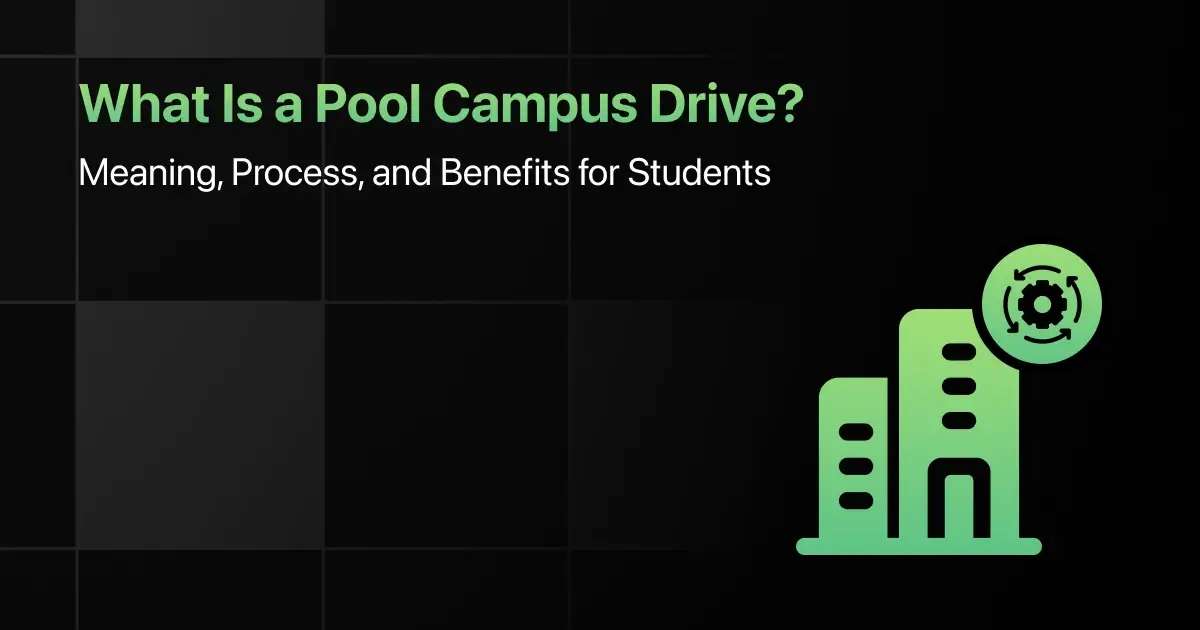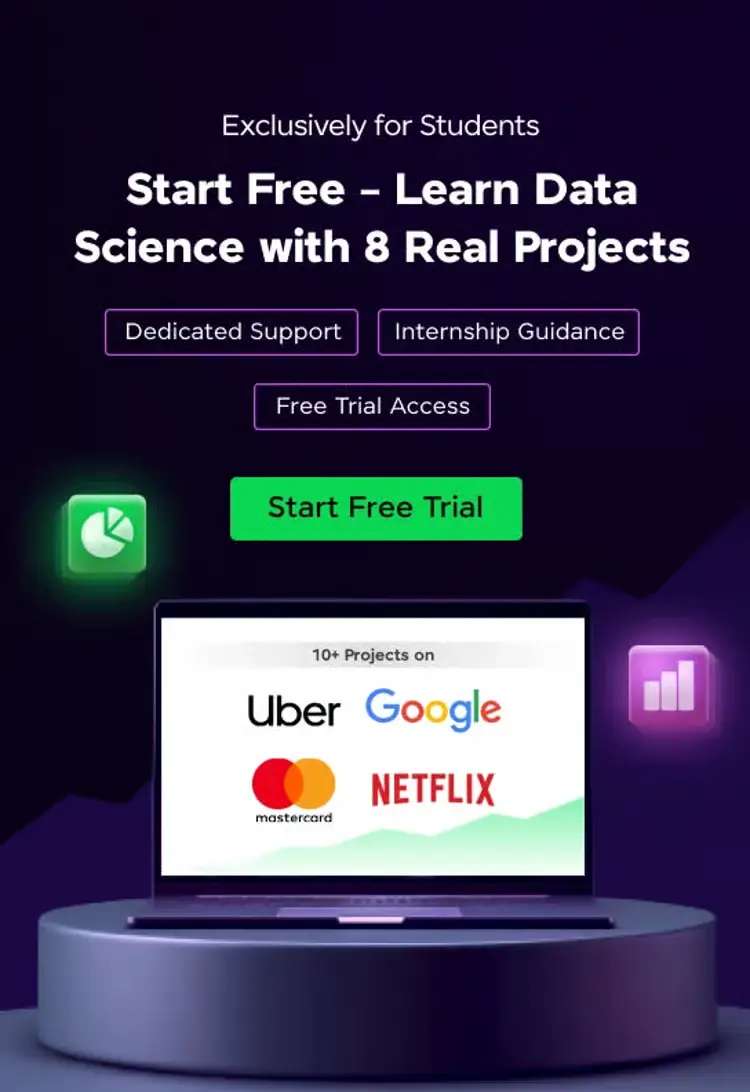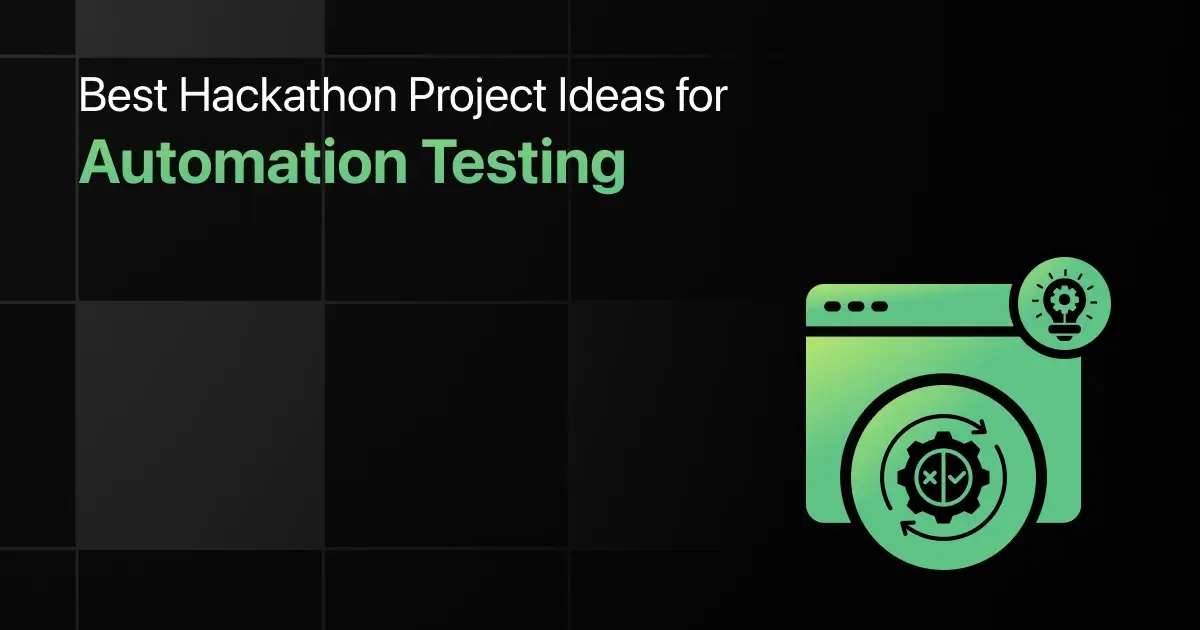What Is a Pool Campus Drive? Meaning, Process & Benefits – Guide

Quick Definition
A Pool Campus Drive is when companies conduct a single recruitment event for multiple colleges together, either offline or online, allowing more freshers to get equal hiring opportunities.
Introduction
Have you ever felt that your college’s name determines your future? Some universities get dozens of well-known companies visiting each month… while others never get one. Students who study the same curriculum, exert the same effort, and have similar aspirations do not get the same job opportunities. That inequity is painful.
Many bright students spend their final year clicking refresh on placement portals, or applying randomly to friends’ referrals, hoping for their college to get “at least one good company this year.” With limited companies, self-doubt creeps in even as students perform well.
This is why Pool recruitment for freshers is so important. It dismantles those barriers. The Pool Drive Recruitment Process in India invites multiple colleges together to recruit students, and allows every student, not only those from Tier-1 colleges, to have an equitable opportunity to showcase their skills and receive their first job offer.
What is Pool Drive Recruitment?
A Pool Drive Recruitment, also known as a Pool Campus Drive or Pooled Campus Drive, is a placement process in which multiple colleges are combined into a group and a single recruitment drive is held for all qualified students. Instead of visiting each campus, companies invite students from different colleges to a single venue for the recruitment drive or an online recruiting platform.
Why Do Companies Conduct Pool Drives?
Companies use the pool campus placement process in India because:
1. Faster hiring, many students in one location to interview
2. Cost-effective, no repeated travel to colleges
3. Access to a larger talent pool
4. Better chances to find skilled graduates for various job roles
How does a Pool Campus Drive work?
1. A company will publish the eligibility details (branch, CGPA, skills, batch year) online
2. Students register from different colleges through the college TPOs or a common online portal
3. The drive is either offline, hosted at a common college or an online recruiting platform using proctoring services
4. All students shortlisted must go through the common hiring processes
5. Offers are made to selected candidates at any college that participated in the process
This custom eradicates the disadvantages of “only top colleges receive excellent companies” too, resulting in an even playing ground for all students to compete.
Latest Pool Campus Drives (2025)
1. Aditya Institute of Management Studies (AIMS), Bangalore, “Campus Placement Pool Drive 2025” on 28 Feb 2025.
Students registered: ~715 from various colleges.
Participation: ~50% of registered students.
Outcome/number placed: Not detailed (just “many … shortlisted and called for final rounds”).
2. Dr D. Y. Patil B‑School, Pune, “TCS Mega Pool Campus Recruitment Drive 2025” on 28 Apr 2025.
Participants: “more than 700 students from diverse academic backgrounds” attended.
Offers/placed: “A large number of students successfully secured job offers”
Pool Drive Recruitment Process in India: Step-by-Step Guide
If it is your first time applying for the Pool Drive Recruitment Process in India, it may appear confusing and intimidating with different colleges, strict eligibility, and competitive recruitment assessments; however, once you have a grip on the process flow, you will know what to expect for each step. Before going into all the steps, let’s start with one of the first things that students ask about:
Eligibility Criteria for Pool Campus Drive
Most companies expect the students/ freshers to have:
- Education: Engineering, Diploma, B.Sc., BCA, MCA, BBA, MBA (by role)
- Minimum CGPA: Typically 60% to 70% on average or no outstanding backlogs
- Batch Year: Only the year of graduation indicated is valid
- Required Skills: Programming, communication, aptitude, and introductory domain knowledge
If you are eligible according to your institution’s eligibility standards, you will be eligible! Otherwise, you can always chase pooled off-campus drives (that typically have lower or relaxed eligibility requirements).
One Glance Checklist For Pool Drive (You Cannot Ignore This!)
Before you register:
- Organise a robust, ATS-friendly resume
- Collect ID proofs and key academic certificates
- Create candidates’ accounts on the main test engines
- Prepare on aptitude and programming fundamentals
- Page regularly with college TPO and placement portals
Create a Professional Resume on Your Phone. Don’t wait for a laptop, make a resume on the go!
Step-by-Step Process: How To Join the Pool Campus Drive & How To Get a Job Through the Pool Drive?
| Stages | What Happens |
|---|---|
| Registration | Apply & Get Shortlisted |
| PPT | Company Explains Job Role |
| Aptitude Test | Elimination Round |
| GD | Communication Test |
| Technical Interview | Core Skills & Projects |
| HR Round | Personality Assessment |
| Final Round | Selection & Onboarding |
Step 1: Registration & Application Screening
- Students submit applications through their college TPO, the company portal, or career websites.
- It is important to validate the eligibility criteria by checking the details carefully, as any misinformation may lead to disqualification.
- Applications are shortlisted based on academic qualifications and keywords in their resume.
Step 2: Pre-Placement Talk
- The recruiters will give students an overview and details about the company, working with the company, the job role, salary, and potential career progressions.
- The recruiters will provide some Q&A time that allows students to clarify doubts.
- This also enables students to assess if working with the company and the job role aligns with their career objectives.
Step 3: Online Aptitude Test
Most companies have their recruitment process start with an online aptitude test similar to the following:
- Quantitative and logical reasoning
- Verbal ability or a communication test
- An online round of MCQs or a coding exercise, which is technical
Step 4: Group Discussion/Communication Round
Companies use this round to assess:
- Communication and fluency
- Ability to work as a leader and participate in teams
- Logical thought processes
- Confidence under pressure
Not all companies will use this round; normally, service-based organisations will.
Step 5: Technical Interview
Here, students need to demonstrate:
- Your fundamental knowledge of DSA
- Topics like OOP, DBMS, OS, CN
- Your knowledge about the project
- Your internships and certifications related to tech topics
Step 6: HR Interview/Behavioural Round
Skills tested are:
- Overall work attitude
- Flexibility with relocation options
- Salary conversation
- Culture fit
A robust, honest story about your journey may make an impact.
Step 7: Final Selection and Job Offer
- Students will receive an email or through the TPO that informs students either verbally or in written form.
- The student may also receive a call for background verification.
- Accept the offer and go through the onboarding process.
And that’s the entire Pool Drive Recruitment Process in India!
Understand every stage of campus and pool drives to maximize your selection chances.
How to Prepare for Pool Drive Recruitment?
Being successful in a campus drive is the result of preparing smarter than the thousands of other candidates competing with you. Here is a well-researched preparation strategy that can help you get shortlisted and selected quickly.
Step 1: Strengthen Aptitude & Problem-Solving Skills
The majority of candidates are filtered out in the very first round of selection as they underestimate the importance of aptitude.
Recommended Areas Of Focus:
- Quantitative Ability
- Logical Reasoning
- Verbal & Reading Comprehension
Practice 30–45 minutes every day.
Step 2: Build Strong Basics in Core Subjects
Recruiters expect you to be clear on:
- DSA fundamentals
- OOP concepts with real examples
- DBMS joins, normalisation, keys
- Operating Systems, Computer Networks (for tech roles)
Tip: Revise 10–15 commonly asked interview questions for each subject.
Step 3: Hands-on Projects & Internship Proof
Your resume must show application of skills and not verticals and certificates.
What to add:
- College/mini projects
- One real-world problem solved using tech
- Github portfolio
Be prepared to explain your project using STAR after you are offered your first interview.
Step 4: Prepare for Group Discussions & Communication
Group discussions are obviously seen as the “so-called easy round”. However, this is actually the cut-off point for quite a few candidates.
- Speaking for 1–2 mins on trending topics
- Structuring thoughts clearly
- Active listening techniques
- Having basic confidence will help you set yourself apart from others.
Step 5: Practice Mock Interviews
Take mock interviews (technical & HR) from seniors or online platforms. Seek improvement in:
- Introduction pitch
- Behavioral questions
- Clarity and speed of answers
Tip: Record yourself and review body language.
Step 6: Research the Company Before the Drive
Knowing more about the employer gives you better interview answers. Check:
- Company products
- Tech stack or services
- Work culture & interview pattern
- Salary range
Step 7: Stay Updated With Pool Drive Announcements
Follow:
- College TPO groups
- LinkedIn updates
- WhatsApp student communities
- Official career pages
Opportunities fly by; apply immediately once the drive opens.
Top Topics to Prepare for Placements. Cover all the essential aptitudes, DSA, and core subjects that recruiters focus on. Check out.
Where to Find Pool Drive Job Opportunities?
When you have no idea where to begin looking for opportunities in the Pool Campus Drive, it can feel like a full-time job. Fortunately, these trusted platforms and networks will make sure you never miss a hiring notification.
| Platform | What To Get | Why It Helps |
|---|---|---|
| College TPO / Departments | Verified Pool Drive announcements | Fastest official source |
| PlacementPreparation.io | Aptitude prep, company hiring patterns, drive alerts | Students get ready + updated info |
| LinkedIn Jobs & Campus Networks | Recruiter posts and pooled drives notifications | Direct company visibility |
| Company Career Pages | Direct applications & eligibility clarity | No third-party errors |
| Naukri, Indeed Freshers Section | Off-campus & referral-based drives | Good for mass hiring roles |
| State Government Skill Portals (e.g., TASK, NATS, APSSDC) | Mega pool drives by the govt & MNCs | High volume & easy eligibility |
| Jobathon / Hackathons | Skill-based hiring drives | No GPA barriers, skill-first hiring |
How to Apply for Pool Drive placements?
While there may be thousands who apply for pool campus drives, many are rejected at the application stage, before the examination, due to failure to meet the application process criteria. Here’s how to follow the correct course of action:
Step 1: Check Eligibility & Required Documents
Before proceeding with the application, be sure you check:
- Is the degree and branch eligible?
- Is there a percentage/ CGPA shipped criteria?
- Is the pass-out year included?
Be prepared with:
- Updated resume (PDF)
- College ID & Government ID
- Mark sheets from academic experience
Step 2: Get The Registration Link
Where to get your application:
- Through college TPO circulars.
- Through company career portals.
- Through HR posts on LinkedIn.
- Through platforms posted by government skill portals.
- Through PlacementPreparation.io drive updates
Step 3: Fill the Application Form Correctly
- Ensure Email ID & Phone Number are “ACTIVE”;
- Be sure to include your correct academic experience.
- Be sure to add skill keywords for the role you are applying.
Example: If applying for an IT role → Java, Python, SQL, DSA, DBMS
Step 4: Submit Resume In ATS Format
- Document is created with simple fonts & clean formatting.
- Do not use any fancy graphics; ATS cannot read the graphics.
- You can use a HCL GUVI Resume Builder to upload and create your ATS-friendly resumes
Most Recruiters are assessing resumes based on keywords and academic projects to shortlist candidates.
Step 5: Track Status & Test Updates
Be looking for;
- Confirmation of application.
- Admit cards/invitation to test.
- Login /platform details to take the test (SHL, AMCAT, CoCubes).
Step 6: Attend The Drive On Time
It doesn’t matter whether you are online or onsite:
- Reach the venue/test login 30 minutes early
- Carry a valid ID & resume
- Avoid technical issues (stable internet, working laptop)
Step 7: Follow Up With TPO/ Recruiter
After the final round:
- Ask politely about the result timeline
- Stay available for HR verification calls
- Do not spam with repeated messages
- Professional follow-up shows maturity
Benefits and Challenges of Pool Drive Placements
Pool drive placements act as a major gateway for students from Tier-2 and Tier-3 colleges to secure jobs in top companies. However, like any opportunity, it comes with strengths and pitfalls.
| Feature | Benefits of Pool Drives | Challenges in Pool Drives |
|---|---|---|
| Opportunities | Multiple companies at one venue | Higher competition from many colleges |
| Hiring Speed | Faster hiring cycles | Limited time for each candidate to perform |
| Eligibility | Open to a wide range of branches | Shortlisted candidates must be highly prepared |
| Skill Exposure | Experience in different test formats | Frequent rejections can affect confidence |
| Networking | Connect with peers & recruiters | Less personalised attention from HR |
| Access to Brands | Big companies hiring freshers | Higher cut-offs and stricter filtering |
Pool drives give students a first shot at industry, but only those prepared and strategic survive the filtering.
Tips For Successful Campus Placements
Whether it’s a pool drive or an on-campus exam, these steps boost your selection chances:
Actionable Rules to Follow
- Master DSA fundamentals → Arrays, Strings, DP, Trees
- Practice aptitude daily → Speed & accuracy matter in OAs
- Build 1-2 solid projects → Show problem-solving impact
- Learn company-specific test patterns → Reduce surprises
- Take mock tests weekly → Build confidence & reduce errors
- Prepare STAR-format interview answers → Structure matters
- Strengthen core CS subjects → CN + OS + DBMS are interviewer favourites
- Dress professionally and maintain etiquette → First impression counts
- Improve communication skills → Speak clearly, not fast
- Apply consistently → More applications means more chances
With the right roadmap and consistency, first-round failures quickly turn into offer letters.
Learn why mock tests are crucial and how to practice effectively.
On-Campus vs Pool Drive
Let’s clarify how Pool Drives differ from regular campus drives.
| Factor | On-Campus Placement | Pool Drive Placement |
|---|---|---|
| Competition | Limited to one college | Students from many colleges |
| Recruiter Focus | Higher personalized attention | Very limited interaction time |
| Eligibility | Higher preference among college students | Based on skill & shortlisting score |
| Hiring Volume | Usually moderate | Higher bulk hiring roles |
| Pressure Level | Lower | Much Higher |
| Exposure | Single selection environment | Different test formats and recruiters |
| Selection Chances | Higher if you meet the criteria | Depends purely on performance |
Tailoring Your Resume for Pool Drive Applications
Resume Optimization Checklist
- Highlight projects with measurable results
- Include coding profiles (LeetCode, HackerRank, GitHub)
- Add skills aligned with job roles (Java, Python, SQL…)
- Keep the length to 1 page only
- Use role-based keywords for ATS ranking
- Don’t add false certifications; companies verify!
To create a clean, ATS-friendly resume quickly, try HCL GUVI Resume Builder
Final Words
Pool drive placements are a golden opportunity for students who may not have strong on-campus hiring exposure. Yes, the competition is fierce. Yes, rejection is common. But every drive you attend sharpens your skills and increases your chances.
With consistent DSA practice, aptitude training, mock interviews, and a strong resume, you can convert every assessment into a job offer.
Frequently Asked Questions
1. How is Pool Drive placement different from on-campus?
Pool drives include students from multiple colleges, unlike on-campus drives, where only internal students attend. This increases competition but also increases opportunities.
2. When should students start applying for Pool Drive jobs?
Start from the 3rd year onwards for internships and the early 4th year for full-time roles. It’s better to start earlier.
3. Which companies hire freshers through Pool Drive drives?
Companies like TCS, Wipro, Infosys, Cognizant, Accenture, Capgemini, Reliance & HCL hire a large bulk of freshers through pool initiatives.
4. Which is better: on-campus or Pool Drive placement?
On-campus is easier to crack due to lower competition. Pool drive is better for more companies and more attempts. The best approach is to apply for both.
5. Is it hard to get a Pool Drive job as a fresher?
It’s competitive, but with:
- Good DSA & Aptitude
- Projects
- A strong resume
You can easily stand out.
6. What skills are essential to succeed in Pool Drive recruitment?
- DSA & Problem Solving
- Aptitude & Logical Thinking
- Communication Skills
- Core CS Fundamentals
These are the 4 pillars of cracking any fresher hiring drive.
7. How important is resume building in the Pool Drive placement process?
Your resume decides whether you get the OA link or rejection mail. A neat and ATS-optimised resume increases shortlisting chances dramatically.
8. How can PlacementPreparation.io help in Pool Drive placements?
- Latest company-specific questions
- Real OA patterns
- Interview experiences from freshers
- Mock tests and preparation roadmaps
Everything required to convert pool drives into placement offers, all in one place.
Related Posts


Soft Skills Training for College Students: Key Topics & Activities
Are you feeling out of your element preparing for campus placements in India? While there is plenty of discussion about …









